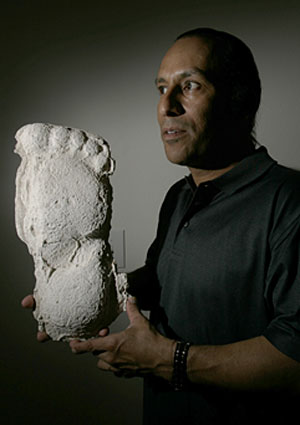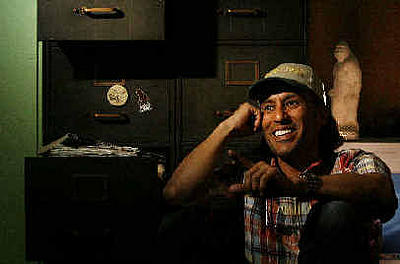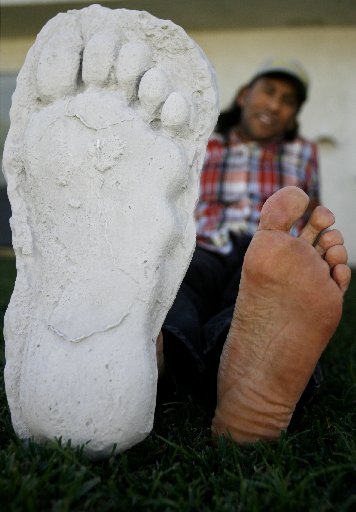Men in Cryptozoology: Daniel Perez
Posted by: Loren Coleman on May 31st, 2008

Daniel Perez holds a 14.5-inch cast of an alleged Bigfoot track from Bluff Creek in Northern California.
May 31, 2008, is Daniel Perez’s 45th birthday.
For over two decades, Perez has held a deep interest in Bigfoot, traveling far and wide, moderating conferences, and putting himself right in the middle of debates and personality conflicts.
Daniel Perez is a people person. He is as well known for seeking in-depth personal information about the pursuers of hairy unknown hominodis as he is for gathering long-forgotten facts about Bigfoot.
Perez is known to many as the “Jerry Springer” of Bigfootry for the rumors he prints in his BigfootTimes newsletter and the fights he’s refereed at conferences. He also has the honor of being called the “Historian of the Camera” for the background data he’s discovered on the filmmaking equipment used by Roger Patterson at Bluff Creek, California, on October 20, 1967.
But there still are lots of people, nevertheless, who merely recall him affectionately as “Danny,” from his youthful, excited, beginning days. However, don’t address him as “Danny,” to his face, any longer, or the next time he writes about you, he’ll use your entire name, including your middle name, even after you ask him not to. LOL. That’s Daniel.
Also, don’t bother Daniel with trying to convince him he should call it “Sasquatch” to sound more scientific. He won’t hear it. To Daniel Perez, it’s “Bigfoot” and we happen to live in interesting “Bigfoot times.”
About many grassroots things, actually, Daniel may be truly correct. Perez is a unique member of the Bigfoot community, a bright and dynamic self-made man and Bigfootry is lucky to have him.
Today seems a great day to review a couple of nice archival mainstream profile articles about the man.
Happy Birthday to Daniel Perez!
The Press-Enterprise, Riverside, California, November 3, 2007.
“Riverside man on the trail of Bigfoot”
Daniel Perez lives in a tidy, two-story home on a quiet Riverside side street, far from the deep, dark backwoods where his real interest walks.
Or doesn’t, depending on what you believe.
By day, Perez toils as a licensed union electrician. But his life’s work is as a dogged researcher and investigator, hot on the hard-to-follow trail of Bigfoot.

Caitlin M. Kelly / The Press-Enterprise
Riverside resident Daniel Perez says he believes there may be more than 100,000 of the Bigfoot creatures in North America today but concedes that any such figure is a “guesstimate” at best.
“It’s an ongoing investigation,” says Perez, 44, who has spent more than 20 years in his pursuit of the legendary creature.
Perez is editor and publisher of the monthly print and online newsletter Bigfoot Times and co-founder of the Center for Bigfoot Studies, both of which he operates from an upstairs study at his home that is packed with files and artifacts.
He is quoted widely in articles and books on Sasquatch, as the hirsute biped is more commonly known in Canada. He even coined some of the phrases that became part of the Bigfoot lexicon, including the term “Bigfooter” to describe devotees.
But perhaps Perez’s biggest claim to Bigfoot fame is as an expert on what is known in Sasquatch circles as “the Patterson-Gimlin film.”
The roughly minute-long 16-millimeter film was shot at Bluff Creek in Northern California in 1967. The film — in which a large, hairy creature turns to face the camera before striding off into the woods — is the most well-known footage and is upheld by many as proof of Bigfoot’s existence.
Perez’s booklet on the film, “Bigfoot at Bluff Creek,” is often cited as the “bible” on the subject.
On Oct. 20, he served as keynote speaker at a conference in Willow Creek, celebrating the 40th anniversary of the filming by Roger Patterson and Bob Gimlin.
“Daniel is a very dogged investigative researcher,” said Jeffrey Meldrum, an associate professor of anatomy and anthropology at Idaho State University. Meldrum has written extensively on the evolution of primates and authored a recent book on Sasquatch.
“His forte is a penchant for detail. In his investigations he leaves very few loose ends.”
So how does a well-respected Bigfoot expert come to live in the Inland area, not exactly a hotbed of Sasquatch sightings?
It started with a movie, Perez says.
He was 10 when he first watched “The Legend of Boggy Creek,” a documentary-style movie about a Bigfoot-like creature.
“I just became hooked,” says Perez, a wiry fellow with long, black hair under a Bigfoot Times baseball cap. “I never grew out of it.”
Perez, who dropped out after a few months at Humboldt State University, is a self-taught researcher.
He has spent more than two decades researching the creature and investigating purported sightings.
He has journeyed to sites of Bigfoot spottings throughout the Pacific Northwest, in Georgia and Ohio and as far afield as Australia.
Perez has debunked false claims and defended what he believes to be solid evidence.
But he has never seen Bigfoot himself.
The closest Perez has come to a sighting are two tracks he found — the first in Hemet in 1980 and the second near Mt. Whitney a few years later.
Perez came across the Hemet tracks after he responded to reports of Bigfoot sightings in the area. In the woods near a creek, he found a 17-inch footprint.
“That was the first track I saw, and I was like, ‘It’s real!’ ” he said.
Since then, Perez has corresponded regularly with other researchers and with Bigfoot buffs.
In his study, two metal filing cabinets are filled with newspaper clippings, photographs and artifacts. Three bookshelves brim with texts on Bigfoot, cryptozoology and other topics. Plaster casts of Sasquatch and its footprints abound, and photos of Perez with notable researchers are alongside family pictures.
Perez acknowledges that little is known about Bigfoot, despite decades of reported sightings and research.
He says he believes the creatures may have come to North America via a prehistoric ice bridge. They might be descendants of a giant ape that once roamed throughout Asia.
Perez believes Bigfoot is a nocturnal creature that shuns contact with humans.
He believes there may be more than 100,000 of the creatures in North America today but concedes that any such figure is a “guesstimate” at best.
Perez takes heart, however, in the fact that skeptics have been unable, despite several attempts, to successfully duplicate the footage from the Patterson-Gimlin film using a man in a monkey suit as the subject.
He says he will continue on the trail of Bigfoot, investigating incidents such as the photographs shot in September by a hunter in the woods of Pennsylvania that some Bigfooters say could depict a young Sasquatch.
And Perez holds out hope that one day, he will have his own sighting.
“I think about it all the time,” he said.Gregor McGavin
The Press-Enterprise

Los Angeles Times, Los Angeles, California, December 27, 2007.
“Riverside man’s dream is as big as his quarry”
The Center for Bigfoot Studies, like the creature itself, is not easy to find.
It hides amid the forest of homes and thickets of Christmas lights on a quiet Riverside street.
No signs or monster-size tracks point the way, but those in the know can pin it down to an upper floor of one unassuming house. There, jammed inside a few small rooms, sits one of the nation’s largest repositories of Bigfoot lore.
Rows of books, stuffed filing cabinets, sculptures and plaster casts of overgrown feet compete for space in a cluttered world dedicated to the legendary hulking primate.
Daniel Perez, 44, is curator and director of the center, which doubles as his home. It’s not typical Bigfoot habitat, but he couldn’t beat the price. And for Perez it’s the work, not the location, that matters.
“This isn’t about finding some new species of butterfly in South America which would have little impact on your life or mine,” he said. “If we ever find this, it might be the biggest scientific discovery the world has ever seen.”
Perez is no flake. He’s a serious-minded, soft-spoken electrician who let his hobby become his passion and now much of his life. He publishes the monthly Bigfoot Times, circulation 760, and has traveled the country investigating sightings and interviewing witnesses.
A recent newsletter reported a sighting from 1936 in Davistown, Pa. The 81-year-old witness told Perez she had seen an upright animal lurking around her rural home on numerous occasions when she was a girl.
“He must have been 6 feet tall, dark brown, long arms and very hairy,” she said. “Gosh, did we run across the fields into the house.”
Another article is about two men’s claims to have audio recordings of Bigfoot’s “breathing, teeth popping and growls.”
“But our conclusion was that it was nothing more than wind,” a local Bigfoot researcher wrote.
Perez is a believer but also a skeptic.
Hoaxers have tried to con him, and promising leads have unraveled. Critical evidence, such as a hefty ape-like skull allegedly found near Bishop, has had a habit of disappearing. Yet there are the stories that keep him going, the strikingly similar accounts of hairy, stinking, bipedal animals stomping through forests from Canada to California to Ohio.
Tales of ape men leading clandestine lives in the North American backwoods go back centuries. Native Americans called them Sasquatches. But the modern Bigfoot phenomenon really got its start in 1958, Perez said, when workers began finding large footprints while building a road in Oregon.
“Some guy took the story to the local newspaper, and the word ‘Bigfoot’ was born,” he said.
In 1986, Perez interviewed members of a six-man crew building a bridge 26 miles south of California’s Mt. Whitney who reported seeing a large upright creature that left 13-inch footprints in its wake.
“It scared the heebie-jeebies out of them,” said Perez, who interviewed the workers at the scene. “One guy told me it sounded like an elephant trumpeting. Another said it was a bloodcurdling scream which resembled a woman being tortured. These were serious, grown men with no reason to lie. It was my first experience with multiple sightings. I was hooked after that.”
Actually, he was hooked before that.
Perez’s pursuit of Bigfoot began at age 10 after he watched “The Legend of Boggy Creek” at a Norwalk theater. The documentary-style film dealt with a Bigfoot-like beast frightening rural Fouke, Ark.
“I thought it was just another monster movie, but it turned out to be the paving stone to who I am today,” he said. “I was curious but skeptical.”
He immediately went to the library and withdrew books about Bigfoot and other creatures, including the Loch Ness monster. He wrote letters to Bigfoot experts, who impressed him with their earnestness.
“It was almost like a science project for him,” recalled his father, Edward Perez. “It was something to keep him busy and enabled him to figure out what’s what.”
The elder Perez questions the whole thing.
“Whenever the subject is broached, I ask him, ‘Where are the bodies? Why are there no bodies?’ ”
In 1979, Perez rushed with a friend to Hemet’s Diamond Valley, chasing reports that huge footprints had been found there. He and his friend saw and measured the proof, he said. The prints were 17 inches long.
He started interviewing people who claimed to have seen Bigfoot. He dug up newspaper clippings from as far back as 1889 reporting encounters with the creature and other “wild men” of the woods. He researched Native American stories of Sasquatch, Himalayan tales of the Yeti and sightings of the Yowie in Australia.
“I understand that many people are ignorant of the data on the subject, but this is more than just tabloid stuff,” he said, picking up a cast of a large footprint. “As you can see, it’s very manlike. It walks like us and has feet like us, but it’s covered in hair and has gorilla-like features. It could be a missing link.”
Perez is writing a book about the Patterson-Gimlin film, a grainy 60-second movie purporting to show a large primate walking through Bluff Creek in Northern California. It was shot by Robert Gimlin and the late Roger Patterson.
The film, shot in 1967, still generates controversy. Believers say it’s the best evidence that Bigfoot exists. Others say it’s the best proof the whole thing is bogus. The doubters’ case was bolstered when Bob Hieronimus of Yakima, Wash., announced in 2004 that he was the film’s Bigfoot. He said Patterson offered him $1,000 to don a gorilla suit.
“Why they keep focusing on this film is beyond me,” said Robert Kiviat, producer of “World’s Greatest Hoaxes: Secrets Finally Revealed,” a Fox Network show that investigated the film.
Kiviat, who appeared with the self-proclaimed hoaxer on MSNBC’s “Countdown With Keith Olbermann” when Hieronimus made his claim, said most people laughed at the film. “It is essentially a few brief seconds of what appears to be a man walking in a gorilla suit in the woods,” he said. “But I do believe there is a mysterious animal out there. We have some hair, some DNA and some video and photographic evidence that is tantalizing.”
Perez doesn’t buy the fraud story. He says Hieronimus could never fill an 8-foot gorilla suit, and he says the suit has never been found.
He has analyzed the footage hundreds of times. He has enlarged it and slowed it down. He points out what he sees as telling details of authenticity.
“You can see the breasts on the subject. That tells us it is female,” he said. “It would seem if you wanted to fake something, you wouldn’t put breasts on it, because it would seem outlandish. You can see the buttocks and the spinal cord. Look how it walks. No human walks like that. Superficially it looks like a man, but when you look closely, it’s clearly not.”
Perez’s views are largely supported by Jeffrey Meldrum, professor of anthropology and anatomy at Idaho State University, who has studied Bigfoot for more than a decade.
“Daniel is a very skilled investigator who goes after details and ties up loose ends,” he said. “Correlating evidence is very important in this study.”
Meldrum, an expert on primate morphology, says the hoax stories don’t hold up under scrutiny.
“If you watch the film as a student of anatomy, primates and locomotion, you can see the movement of the shoulder blade under the skin,” he said. “I can see the calf muscles contract at the appropriate moments. When anyone tries to replicate it in any way, it doesn’t look like a primate.”
His theory?
“You can never be 100% sure of anything, but beyond a reasonable doubt I am convinced it portrays a real animal,” he said. “My working hypothesis is they are a species of great ape restricted to the ground but having an arboreal legacy. They would most likely be related to the orangutans.”
Meldrum said the lack of Bigfoot corpses is not a mystery given the remote spots where they are believed to live as well as the dampness of the forest and the acidic quality of forest soil, which encourages decomposition.
Upstairs in his office, Perez plays the Patterson-Gimlin film on his computer again and again.
He thinks as many as 100,000 Bigfoots could be roaming North America, but he knows he may never find even one of them.
“A lot of early researchers thought we would solve the mystery in a few years, but we haven’t,” he said. “I can’t prove Bigfoot exists, but either someone has been fabricating tracks for over a hundred years or there is a real animal out there.” David Kelly
Los Angeles Times Staff Writer

About Loren Coleman
Loren Coleman is one of the world’s leading cryptozoologists, some say “the” leading living cryptozoologist. Certainly, he is acknowledged as the current living American researcher and writer who has most popularized cryptozoology in the late 20th and early 21st centuries.
Starting his fieldwork and investigations in 1960, after traveling and trekking extensively in pursuit of cryptozoological mysteries, Coleman began writing to share his experiences in 1969. An honorary member of Ivan T. Sanderson’s Society for the Investigation of the Unexplained in the 1970s, Coleman has been bestowed with similar honorary memberships of the North Idaho College Cryptozoology Club in 1983, and in subsequent years, that of the British Columbia Scientific Cryptozoology Club, CryptoSafari International, and other international organizations. He was also a Life Member and Benefactor of the International Society of Cryptozoology (now-defunct).
Loren Coleman’s daily blog, as a member of the Cryptomundo Team, served as an ongoing avenue of communication for the ever-growing body of cryptozoo news from 2005 through 2013. He returned as an infrequent contributor beginning Halloween week of 2015.
Coleman is the founder in 2003, and current director of the International Cryptozoology Museum in Portland, Maine.










Good morning Cryptos…
I don’t know much about Daniel, however folks speak well of him. I would like to subscribe to his online newsletter.
If the possible habituation extrapolations are accurate…his population guestimate may be conservative…JMHO
Sometimes…I have a hard time taking opinions, skeptical or otherwise too seriously..when they have never encountered the Big Folks…but that’s just me.
live and let live…
ole bub and the dawgs
Ok, can we call him ‘Danielito’ instead? 😉
Feliz Cumpleaños!
this is a wonderful new article about sasquatch researcher daniel perez, hey daniel HAPPY BIRTHDAY… keep on researching sasquatch. thanks bill green 🙂
My Bad Cryptos….
Happy Birthday…Daniel…keep on squatching…how do I subscribe to your newsletter?
live and let live…
ole bub and the dawgs
Happy Belated Birthday Daniel!